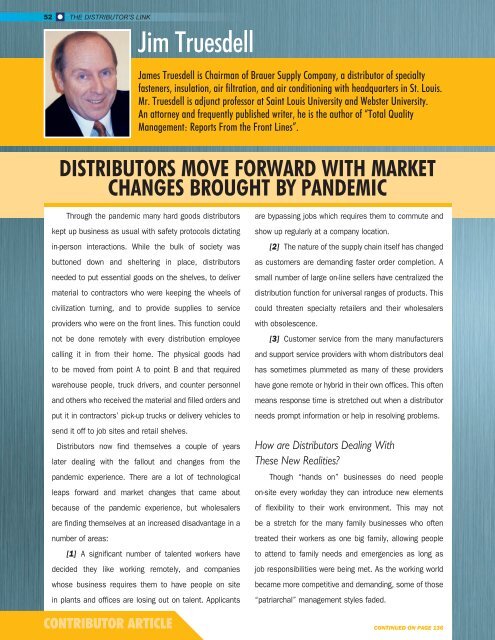FALL 2023
Distributor's Link Magazine Fall 2023 / Vol 46 No 4
Distributor's Link Magazine Fall 2023 / Vol 46 No 4
You also want an ePaper? Increase the reach of your titles
YUMPU automatically turns print PDFs into web optimized ePapers that Google loves.
52<br />
THE DISTRIBUTOR’S LINK<br />
Jim Truesdell<br />
James Truesdell is Chairman of Brauer Supply Company, a distributor of specialty<br />
fasteners, insulation, air filtration, and air conditioning with headquarters in St. Louis.<br />
Mr. Truesdell is adjunct professor at Saint Louis University and Webster University.<br />
An attorney and frequently published writer, he is the author of “Total Quality<br />
Management: Reports From the Front Lines”.<br />
DISTRIBUTORS MOVE FORWARD WITH MARKET<br />
CHANGES BROUGHT BY PANDEMIC<br />
Through the pandemic many hard goods distributors<br />
kept up business as usual with safety protocols dictating<br />
in-person interactions. While the bulk of society was<br />
buttoned down and sheltering in place, distributors<br />
needed to put essential goods on the shelves, to deliver<br />
material to contractors who were keeping the wheels of<br />
civilization turning, and to provide supplies to service<br />
providers who were on the front lines. This function could<br />
not be done remotely with every distribution employee<br />
calling it in from their home. The physical goods had<br />
to be moved from point A to point B and that required<br />
warehouse people, truck drivers, and counter personnel<br />
and others who received the material and filled orders and<br />
put it in contractors’ pick-up trucks or delivery vehicles to<br />
send it off to job sites and retail shelves.<br />
Distributors now find themselves a couple of years<br />
later dealing with the fallout and changes from the<br />
pandemic experience. There are a lot of technological<br />
leaps forward and market changes that came about<br />
because of the pandemic experience, but wholesalers<br />
are finding themselves at an increased disadvantage in a<br />
number of areas:<br />
[1] A significant number of talented workers have<br />
decided they like working remotely, and companies<br />
whose business requires them to have people on site<br />
in plants and offices are losing out on talent. Applicants<br />
CONTRIBUTOR ARTICLE<br />
are bypassing jobs which requires them to commute and<br />
show up regularly at a company location.<br />
[2] The nature of the supply chain itself has changed<br />
as customers are demanding faster order completion. A<br />
small number of large on-line sellers have centralized the<br />
distribution function for universal ranges of products. This<br />
could threaten specialty retailers and their wholesalers<br />
with obsolescence.<br />
[3] Customer service from the many manufacturers<br />
and support service providers with whom distributors deal<br />
has sometimes plummeted as many of these providers<br />
have gone remote or hybrid in their own offices. This often<br />
means response time is stretched out when a distributor<br />
needs prompt information or help in resolving problems.<br />
How are Distributors Dealing With<br />
These New Realities?<br />
Though “hands on” businesses do need people<br />
on-site every workday they can introduce new elements<br />
of flexibility to their work environment. This may not<br />
be a stretch for the many family businesses who often<br />
treated their workers as one big family, allowing people<br />
to attend to family needs and emergencies as long as<br />
job responsibilities were being met. As the working world<br />
became more competitive and demanding, some of those<br />
“patriarchal” management styles faded.<br />
CONTINUED ON PAGE 136
















